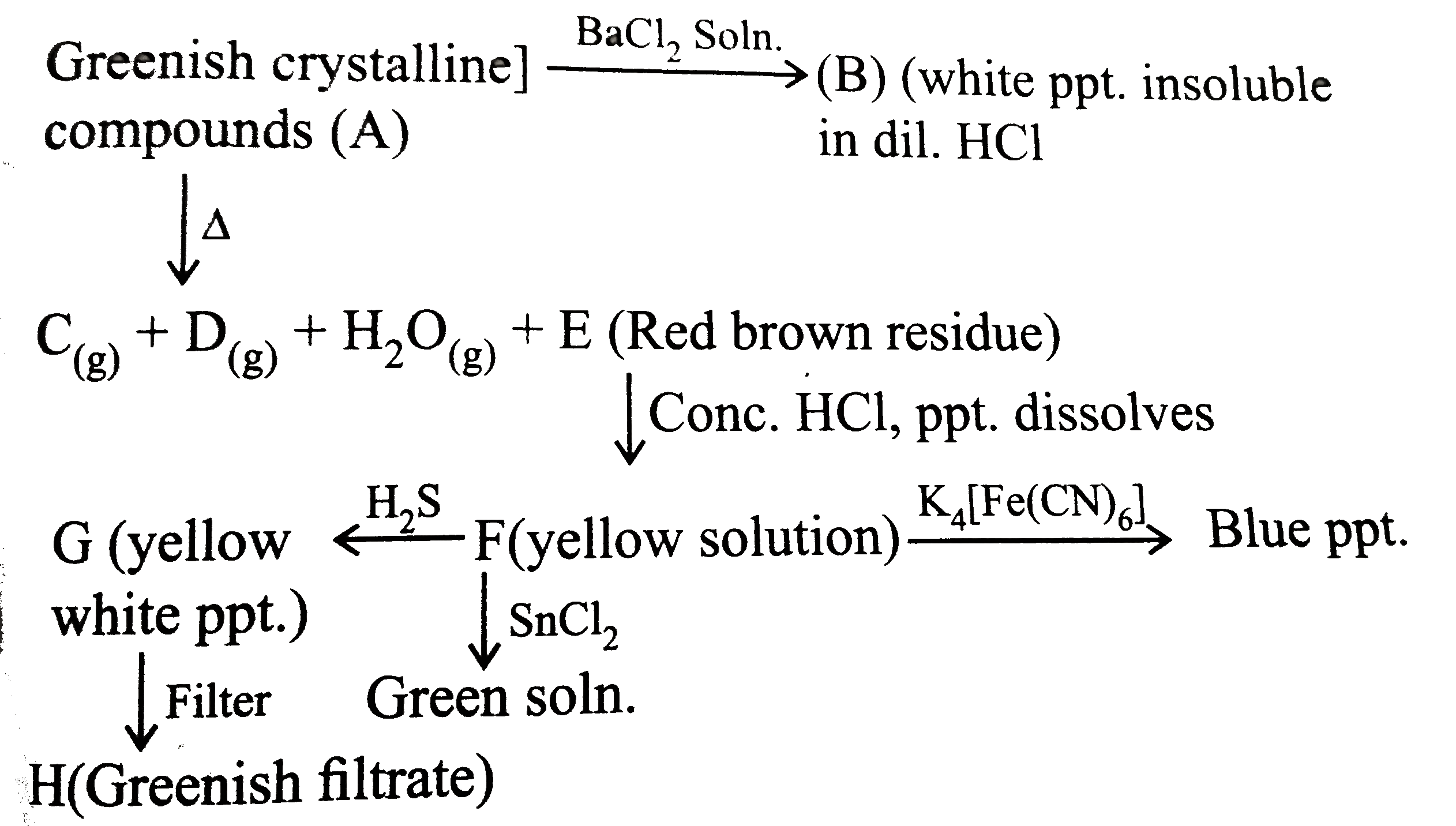
Gases C and D are
SO2,SO3
SO3,CO2
NO2,MgO
ZnO,SO3
The correct Answer is:a
(A) is FeSO4.7H2O
FeSO4+BaCl2→BaSO4↓(B)+FeCl2
2FeSO4Δ−−→Fe2O3(E)+SO2(C)+SO3(D)
Fe2O3+6HCl→2FeCl3(F)+3H2O
2FeCl3+H2S→2FeCl2(H)+2HCl+S(G)
2FeCl3+SnCl2→2FeCl2+SnCl4
4FeCl3+3K4Fe(CN)6→Fe4[Fe(CN)6]3Prussian blue+12KCl
Topper's Solved these Questions
- QUALITATIVE INORGANIC SALT ANALYSISBOOK - CENGAGE CHEMISTRYCHAPTER - QUALITATIVE INORGANIC SALT ANALYSISEXERCISE - Exercises (Multiple Correct) Part-A (Analysis Of Anions)
31 Videos
- QUALITATIVE INORGANIC SALT ANALYSISBOOK - CENGAGE CHEMISTRYCHAPTER - QUALITATIVE INORGANIC SALT ANALYSISEXERCISE - Exercises (Multiple Correct) Part-B (Analysis Of Cations)
30 Videos
- QUALITATIVE INORGANIC SALT ANALYSISBOOK - CENGAGE CHEMISTRYCHAPTER - QUALITATIVE INORGANIC SALT ANALYSISEXERCISE - Solved Example
11 Videos
- P-BLOCK GROUP 18 ELEMENTS - THE INERT GASESBOOK - CENGAGE CHEMISTRYCHAPTER - P-BLOCK GROUP 18 ELEMENTS - THE INERT GASESEXERCISE - Ex 5.1 (Objective)
14 Videos
- REDUCTION AND OXIDATION REACTION OF ORGANIC COMPOUNDSBOOK - CENGAGE CHEMISTRYCHAPTER - REDUCTION AND OXIDATION REACTION OF ORGANIC COMPOUNDSEXERCISE - SUBJECTIVE TYPE
3 Videos
Similar Questions
Two gases A and B which react according to the equation
aA(g)+bB(g)→cC(g)+dD(g)
to give two gases C and D are taken (amount not known) in an Eudiometer tube (operating at a constant Pressur and temperature) to cause the above.
If one causing the reaction there is no volume change observed then which of the following statement is/are correct.
View SolutionThe various conditions required for the liquefaction of gases A, B, C and D are given below:

View Solution
Knowledge Check
Two gases A and B which react according to the equation
aA(g)+bB(g)→cC(g)+dD(g)
to give two gases C and D are taken (amount not known) in an Eudiometer tube (operating at a constant Pressur and temperature) to cause the above.
If one causing the reaction there is no volume change observed then which of the following statement is/are correct.A(a+b)=(c+d)Baverage molecular mass may increase or decrease if either of A or B is present in limited amount.CVapour Density of the mixture will remain same throughout the course of reaction.DTotal moles of all the component of mixture will change.At certain temperature the volume - pressure curves for four gases A , B , C and D are as shown below . The gas that deviates least from ideal nature is
 ABBDCCDA
ABBDCCDACritical temperatures of the gases A, B, C and D are
(a) 5.2K (b) 33.2 K
(c )126.3 K (d) 191.1 K
Arrange them in the ascending order of intermolecular forces of attraction.AC,B,D,ABA,B, C,DCD,C,B,ADA,C,B,D
The critical temperature of gases A, B, C and D are −118∘C, −240∘C, 132∘C and 20∘C, respectively. Arrange them in the decreasing order of intermolecular force of attraction.
View SolutionThe volumes of gases A, B, C and D are in the ratio, 1:2:2:4 under the same conditions of temperature and pressure.
Which sample of gas contains the maximum number of molecules?
View SolutionThe volumes of gases A, B, C and D are in the ratio, 1:2:2:4 under the same conditions of temperature and pressure.
If this ratio of gas volumes refers to the reactants and products of a reaction, which gas law is being observed?
View SolutionThe volumes of gases A, B, C and D are in the ratio, 1:2:2:4 under the same conditions of temperature and pressure.
If the temperature and the pressure of gas A are kept constant, then what will happen to its volume when the number of molecules is doubled?
View SolutionMnO2+HClΔ−−→A(g)
A(g)+F2(excess)573K−−→B(g)
B(l)+U(s)→C(g)+D(g)
The gases A,B, C and D are respectively ________.
View Solution
